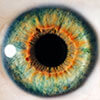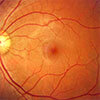Retinal Vein Occlusion
Vein Occlusion Follows Vascular Diseases
Did you know? High blood pressure and other vascular diseases can affect your vision by damaging veins in the retina.
High blood pressure is the most common condition associated with branch retinal vein occlusion (BRVO). About 10 to 12 percent of the people who have BRVO also have glaucoma (high pressure in the eye).
Vein Occlusion May Cause Vision Loss
Retinal vein occlusions commonly occur with glaucoma, diabetes, vascular disease, high blood pressure and blood disorders.
Your eye doctor will try to determine the cause of the problem and prescribe a treatment plan to preserve or improve your vision. A number of treatments may be appropriate and can often reverse the disease process, sometimes restoring vision.
Branch retinal vein occlusion
BRVO blocks small veins in the retina, the layer of light-sensing cells at the back of the eye.
Some central vision is lost if the blocked retinal veins are ones that nourish the macula, the part of the retina responsible for reading vision. During the course of vein occlusion, 60 percent of people will have swelling of the macula. This macular swelling (edema) will remain for about a year in one-third of the people if it goes untreated.
BRVO causes a painless decrease in vision, resulting in misty, distorted or blurred vision. If the veins cover a large area, new abnormal vessels may grow on the retinal surface, which can bleed into the eye, blocking the retina and causing blurred vision.
Your eye doctor may recommend a period of observation, since hemorrhages and excess fluid may subside on their own. If the central retina is involved or abnormal blood vessels develop, your retina specialist will direct your treatment to help maintain or recover vision.
Your eye care specialist also will order studies to identify the cause of the blockage in order to minimize the risk of a second event in the eye or elsewhere. If you have had a branch retinal vein occlusion, regular visits to your eye doctor are essential to protect vision.
Central retinal vein occlusion
Central retinal vein occlusion (CRVO) blocks the main vein in the retina, the light-sensitive nerve layer at the back of the eye.
The blockage causes the walls of the vein to leak blood and excess fluid into the retina, often resulting in macular edema, or swelling in the central retina.
Vision becomes blurry when this fluid collects in the macula, the area of the retina responsible for central vision. Blotchy vision or intermittent vision loss are other symptoms of CRVO.
Another sign: New floaters in your eye
New floaters in your vision are another symptom of CRVO. When retinal blood vessels are not working properly, the retina grows new fragile vessels that leak blood into the vitreous, the fluid that fills the center of the eye. Blood in the vitreous clumps and is seen as tiny dark spots, or floaters, in the field of vision.









